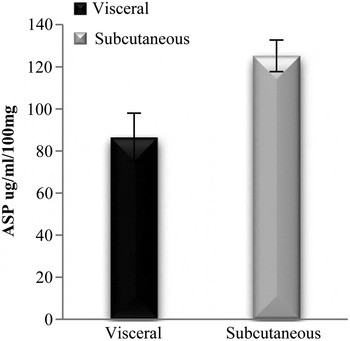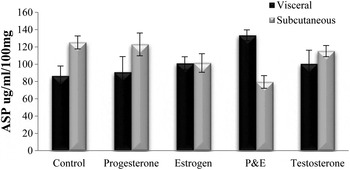Acylation Stimulating Protein (ASP) is a hormone produced by adipose tissue that exhibits lipogenic properties. It enhances triacylglycerol (TG) uptake and postprandial TG clearanceReference Cianflone, Xia and Chen 1 . Progesterone has been shown to stimulate ASP -mediated TG clearanceReference Al Riyami, El Tahir and Al Maskari 2 . Addition of chylomicrons to the media of cultured adipocytes also stimulates ASP productionReference Scantlebury, Maslowska and Ciaflone 3 . The aim of the present study was to investigate the effect of sex hormones on ASP production, in the absence and presence of chylomicrons, in ex vivo adipose tissue explants isolated from ovariectomized rats.
Adipose tissue explants (n = 6) were incubated with physiological levels of progesterone, estrogen, progesterone & estrogen (P&E) and testosterone for 24 hours at 37 °C in the absence or presence of chylomicrons. Media ASP was measured by ELISA and results are presented as mean ±SEM with significant differences set at * P < 0·05 using Dunnett t post hoc analysis.
In the absence of hormones, ASP concentrations in the explant media were higher in subcutaneous than visceral tissue (Fig.1, P = 0·026). In the presence of chylomicrons, hormone treatment significantly affected ASP level in media from visceral (F (4,78) = 6·41, P < 0·001) and subcutaneous tissue (F (4,81) = 3·92, P = 0·006). Post hoc analysis showed a significant increase in P&E group compared to control groups (Fig. 2, P = 0·006) in the visceral adipose tissue explant cultures. The same group showed a significant reduction of ASP level in subcutaneous explant media (Fig. 2, P = 0·004). Hormones had no significant effect in the absence of chylomicrons (data not shown).

Fig. 1. ASP levels in the control group

Fig. 2. ASP levels with different hormone treatments
The higher ASP concentrations in media from in the subcutaneous tissue explants agrees with previous findings that ASP stimulates TG synthesis to a greater extent in subcutaneous adipocytesReference Walsh, Sniderman and Cianflone 4 . The combination of P&E has opposite effects, depending on adipose tissue depot. Further analysis of related gene expression will explore whether this is the result of the changes in production or increased uptake of ASP into adipocyte through its receptor.
AA-R was supported by a PhD studentship from the Omani government.



